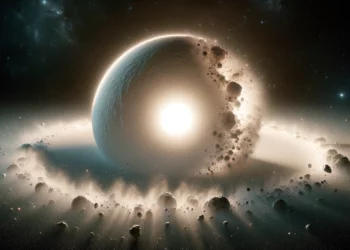
Novae are always a cool find. The strong light bursts are caused by a two-star system in which a white dwarf — the result of a small or medium star running out of nuclear fuel and shedding its outer layers — sucks matter from its partner, which subsequently falls back into the white dwarf. This matter is heated by the white dwarf, resulting in an uncontrolled reaction that unleashes a powerful burst of energy that makes the system shine a million times brighter than normal. The matter is shot away at great speeds by the explosion, which we see as visible light.
While the events are extremely dramatic in themselves, now astronomers have found an even more spectacular nova.
The fastest nova ever observed has initiated a buzz among astronomers, drawing attention to an even stranger star. Researchers may now be able to discover answers to more than just the nova’s many mysterious traits, but to larger questions about the chemistry of our solar system, the death of stars and the evolution of our universe.
A blazing nova will normally dissipate in a few weeks or longer. However, the nova V1674 Hercules, which exploded bright enough to be seen with the naked eye on June 12, 2021, faded away in just over a day. Astronomers said it was just as if someone had flicked a flashlight on and off. In the world of astronomy, events at this level of speed are extremely rare.
“It was only about one day, and the previous fastest nova was one we studied back in 1991, V838 Herculis, which declined in about two or three days,” said Sumner Starrfield, an astrophysicist in Arizona State University’s School of Earth and Space Exploration, and an author of the study published in the Research Notes of the American Astronomical Society, in a press release.
Observers spotted a wobble in both visible light waves and X-rays every 501 seconds. The nova is still wobbling a year after it exploded, and it appears to have been going on for even longer. Starrfield and his colleagues have continued to look into this strange phenomenon.
“The most unusual thing is that this oscillation was seen before the outburst, but it was also evident when the nova was some 10 magnitudes brighter,” said Mark Wagner from The Ohio State University who co-authored the report, and is also the head of science at the Large Binocular Telescope Observatory being used to observe the nova. “A mystery that people are trying to wrestle with is what’s driving this periodicity that you would see it over that range of brightness in the system.”
While monitoring the matter expelled by the nova explosion, the scientists found something strange: some form of wind is influencing the flow of material into space surrounding the system, which may be based on the locations of the white dwarf and its partner star.
“We are trying to obtain more observations to better understand the system—both the white dwarf and the secondary star,” Starrfield told ZME Science. “We are not yet confident that we know which star is producing the wind and we need to know that before we can try to determine the cause.”
Though the fastest nova is (literally) flashy, it’s worth studying because novae can reveal significant details about our solar system and even the entire cosmos.
During a nova explosion, a white dwarf accumulates and modifies matter, then peppers the surrounding space with new material. It’s a crucial aspect of the matter-in-space cycle. Novae eject elements that will eventually create new star systems. Such events also aided in the formation of our solar system, ensuring that Earth was more than just a carbon blob.
“We’re always trying to figure out how the solar system formed, where the chemical elements in the solar system came from,” Starrfield said in the press release. “One of the things that we’re going to learn from this nova is, for example, how much lithium was produced by this explosion. We’re fairly sure now that a significant fraction of the lithium that we have on the Earth was produced by these kinds of explosions.”
What’s even more amazing about the story is that this nova wasn’t discovered by any university or space agency. One of the most amazing novae finds of all time was found by a citizen-scientist, an amateur astronomer from Japan, Seidji Ueda.
“Although there are a number of all-sky surveys, we still depend on amateurs to discover novae,” Starrfield said in an email. “This nova was discovered by an amateur in Japan.”
Researchers now intend to look into the cause of the outburst and the processes that led to it, as well as the explanation for the outburst’s record-breaking decrease, the forces that caused the observed wind and the cause of the pulsating brilliance.
In his email, Starrfield said they will be following up the discovery with optical spectroscopy, photometry (including infrared), X-rays with the Neil Gehrels Swift Satellite, and “anything that we can get pointed at this nova.”






